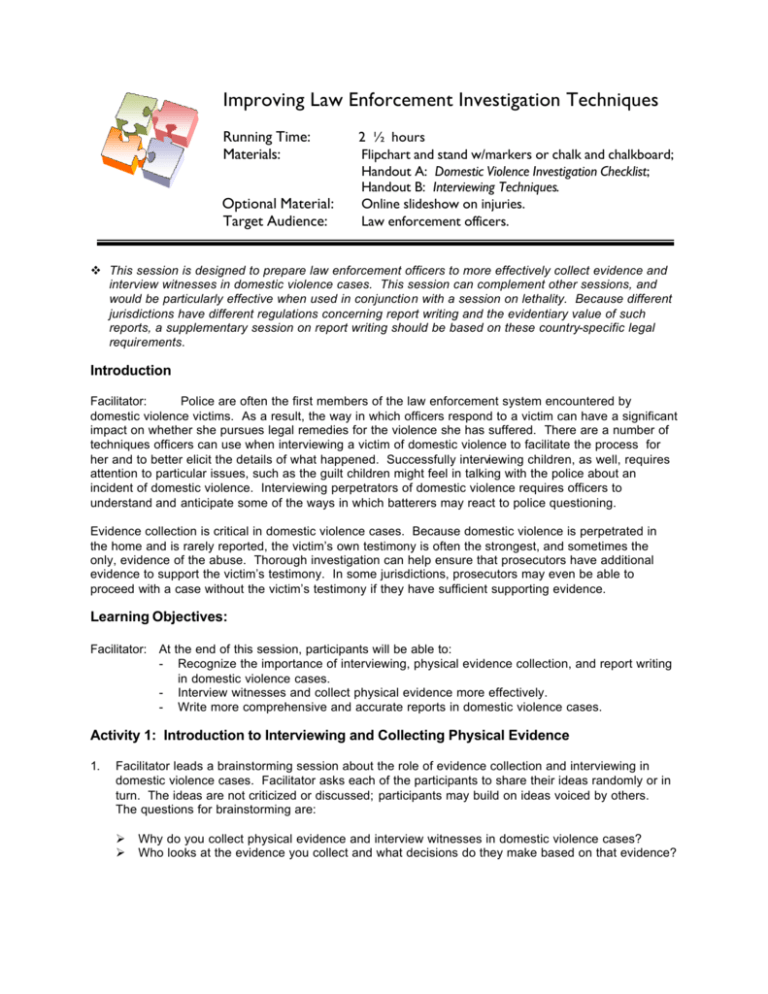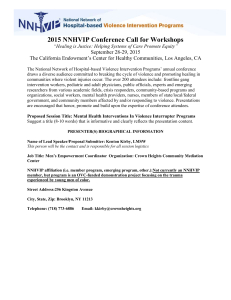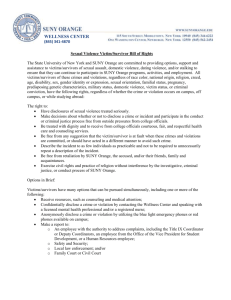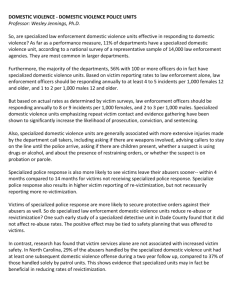Improving Law Enforcement Investigation Techniques
advertisement

Improving Law Enforcement Investigation Techniques Running Time: Materials: Optional Material: Target Audience: 2 ½ hours Flipchart and stand w/markers or chalk and chalkboard; Handout A: Domestic Violence Investigation Checklist; Handout B: Interviewing Techniques. Online slideshow on injuries. Law enforcement officers. v This session is designed to prepare law enforcement officers to more effectively collect evidence and interview witnesses in domestic violence cases. This session can complement other sessions, and would be particularly effective when used in conjunction with a session on lethality. Because different jurisdictions have different regulations concerning report writing and the evidentiary value of such reports, a supplementary session on report writing should be based on these country-specific legal requirements. Introduction Facilitator: Police are often the first members of the law enforcement system encountered by domestic violence victims. As a result, the way in which officers respond to a victim can have a significant impact on whether she pursues legal remedies for the violence she has suffered. There are a number of techniques officers can use when interviewing a victim of domestic violence to facilitate the process for her and to better elicit the details of what happened. Successfully interviewing children, as well, requires attention to particular issues, such as the guilt children might feel in talking with the police about an incident of domestic violence. Interviewing perpetrators of domestic violence requires officers to understand and anticipate some of the ways in which batterers may react to police questioning. Evidence collection is critical in domestic violence cases. Because domestic violence is perpetrated in the home and is rarely reported, the victim’s own testimony is often the strongest, and sometimes the only, evidence of the abuse. Thorough investigation can help ensure that prosecutors have additional evidence to support the victim’s testimony. In some jurisdictions, prosecutors may even be able to proceed with a case without the victim’s testimony if they have sufficient supporting evidence. Learning Objectives: Facilitator: At the end of this session, participants will be able to: - Recognize the importance of interviewing, physical evidence collection, and report writing in domestic violence cases. - Interview witnesses and collect physical evidence more effectively. - Write more comprehensive and accurate reports in domestic violence cases. Activity 1: Introduction to Interviewing and Collecting Physical Evidence 1. Facilitator leads a brainstorming session about the role of evidence collection and interviewing in domestic violence cases. Facilitator asks each of the participants to share their ideas randomly or in turn. The ideas are not criticized or discussed; participants may build on ideas voiced by others. The questions for brainstorming are: Ø Ø Why do you collect physical evidence and interview witnesses in domestic violence cases? Who looks at the evidence you collect and what decisions do they make based on that evidence? v Write down each answer as they are offered on a flipchart or chalkboard without any comments, notes or questions for 5-7 minutes. After discussing the ideas, post the list on the wall or leave the list on the chalkboard so it is visible throughout the training workshop. v Possible answers to these questions include: law enforcement supervisors and police headquarters, both to evaluate officers’ performance and to determine where additional resources are needed; battered women’s groups monitoring police response to domestic violence; prosecutor; judge; child welfare advocates; probation officers; defense attorneys; jury; batterers’ treatment program. v This brainstorming session not only helps participants to start talking about why evidence collection is important, but also provides the facilitator with an opportunity to assess participants’ level of knowledge about the legal framework that applies to domestic violence cases. 2. Facilitator explains that the co-facilitators will be engaging in a role-play in which law enforcement officers are responding to a call from a woman whose husband just assaulted her: v Facilitators can modify the role play included with this training to reflect specific circumstances in the country. w Ask the participants to take notes on what they think the officers do well and what could have been improved. w Explain that the officers will be talking with the battered woman about a number of other issues, including lethality, safety planning, and resources for victims of domestic violence, that are not covered in the instant session. v Note that this activity could be expanded to include elements of the sessions on lethality assessments, safety planning, guidelines for advocates, and local resources available for battered women. 3. After the role play, facilitator reconvenes the large group and leads a guided discussion with participants on the following questions: Ø Ø Ø Ø What evidence did the officers collect? What did they do well and what could have been improved in terms of evidence collection? What did they do well and what could have been improved in terms of interviewing witnesses? Is there anything else you noticed? At the conclusion of the guided discussion, the facilitator can give each participant a copy of Handout A: Domestic Violence Investigation Checklist. Activity 2: Evidence Collection Techniques Facilitator conducts a mini-lecture on collecting evidence, highlighting the following points: w Many of the procedures recommended for domestic violence cases are procedures officers may already follow when investigating crimes such as burglary or assault. The same investigative process used in these crimes should be used to collect evidence in domestic violence cases. w Investigation can be particularly critical if the jurisdiction allows prosecutors to go forward with a case even after a victim seeks to withdraw the complaint or refuses to testify. Without the victim’s testimony, other evidence is critical to the success of the prosecution. w Taking photographs can be an important part of investigation. Officers should take photographs of the room, particularly if there is property damage or the room is otherwise in disarray because of the fight. w It can also be important to take photographs of the victim’s injuries. At least one photograph of the injuries should include the victim’s face for identification purposes. w Injuries in domestic violence cases may not be immediately apparent. First, some injuries take days before they are externally visible. Bruises and strangulation marks, for example, may not be visible until three to four days after the assault. If possible, police may want to schedule follow-up visits to photograph injuries three to four days after the incident. Second, batterers may deliberately hurt their victims in places that are normally covered by clothing, or in places that would be embarrassing to reveal to strangers. Third, victims may not reveal the cause of some of their injuries, potentially out of fear of retaliation by the batterer. Officers should watch for injuries that would appear to be inconsistent with the explanation offered. v Facilitator may want to illustrate the development of injuries over time through photographs presented in the form of handouts or a slideshow. An online slideshow (described below) contains photographs that may be used for this exercise. Optional Slideshow: Slides 44 through 86, Prosecuting Domestic Violence Cases Without Victim Participation, Casey Gwinn, San Diego City Attorney, 29 October 2001. In English, available at http://www.sandiegodvunit.org/RenoProsecution.102901b.pdf Activity 3: Interviewing Techniques 1. Facilitator conducts a mini-lecture on interviewing victims, highlighting the following points: w It is best to interview the batterer and the victim separately. Ideally, these interviews should take place in separate rooms. v At this point, the facilitator could ask participants why it is important to interview the victim away from the batterer. w Interviewing the batterer and victim separately is important for two reasons. First, this helps increase the likelihood that the victim will feel free to talk about what happened. The victim may be afraid that the batterer will retaliate against her if she describes what happens. Second, the batterer will be less able to make up a story that undermines the victim’s story if he does not hear what she tells the police. w There are a number of things officers can do when interviewing a victim of domestic violence to make the interview process easier for the victim and to better elicit the details of what happened. In addition, the officer may be the first actor within the legal system that the victim has dealt with about the violence. The way in which the interview is conducted can have a significant impact on how she deals with the trauma and her perception of the legal system. v At this point, the facilitator could ask participants what they have done or might pay attention to when interviewing victims. w In interviewing a victim of domestic violence, it is important to let the victim know that you are concerned. Your tone of voice, eye contact and words convey that you are concerned. Officers should try to be non-judgmental and to make no assumptions about who is good or bad. 2. w Let her tell her own story before asking clarifying questions. Many times battered women want to say many things that are not relevant to the police. For example, the woman might say, “He beat me today because for five years we have had an argument about visiting my sister in another town.” Officers should let the woman tell the story for a while and then ask about the incident. w Officers should also acknowledge and pay attention to the victim’s anxiety, fear or terror. She may be distraught, crying, shaking or screaming; she may also be agitated and angry at her batterer. Officers might say, “I can understand why you are upset.” It is important to reassure the victim that help is available, and that she is not to blame for the assault. w Understand that a victim of domestic violence may be suffering from trauma. She may fail to articulate her words clearly, give delayed answers, avoid eye-contact. She may not clearly remember the entire incident. w It is also important to avoid judging victims or commenting on the situation. There are many reasons why a woman may not want to leave an abusive relationship. Offering personal advice to the victim at the scene will not resolve what is a very complex and difficult situation. w It may also be important for officers to try to record the victim’s statements as accurately as possible. These statements will be read by prosecutors and others, and may have evidentiary value if the prosecutor pursues the case. Often, it can be useful to record the victim’s statements in her own words. w Note, as well, that there are many social, economic and cultural reasons a woman might choose to stay in an abusive relationship. The most dangerous time for a battered woman is when she attempts to leave or to use the legal system to protect herself from the violence. She may not cooperate with the responding officers, even if she called the police, if she feels that cooperation would endanger her or her children. Facilitator conducts a mini-lecture on interviewing children, highlighting the following points: w Interviewing children can be difficult. Ideally, officers should be trained to interview children in ways that make them comfortable and allow them to talk to the officer without fear or confusion about what the officer is doing. Officers might be trained on specific interview techniques, as well as the importance of being aware of any indication that the child is fearful of one or both parents. w In addition, it is best to interview children away from both parents. v At this point, the facilitator could ask participants why it is important to interview children separately. w Interviewing a child away from his or her parents makes it more likely that the child will tell the police officer about what he or she fears. If the child is interviewed in the presence of the parents, the danger is that the child will say what he or she believes the parents want him or her to say. w It is important to conduct the interview in a place that is comfortable for the child. The police can attempt to engage at the child’s level. They might sit down so as not to look intimidating, and could start the interview by asking non-threatening questions. w Officers should ask open-ended questions. Questions such as, “Did your father hit your mother?,” might suggest to the child that the officer wants to hear a particular answer. w Police also need to be aware of the child’s inclination to feel responsible or guilty about what has happened. They need to reassure the child that he or she has not done anything wrong. Police could say things like, “We want to get your father some help, and we are going to be helping out your family. And we appreciate your help,” so the child does not feel that she has done something wrong by telling stories. 3. Facilitator conducts a mini-lecture on interviewing perpetrators, highlighting the following points: w Batterers are dangerous. When interviewing them, ask them to sit down. They may attempt to attack the officers or the victim. w Officers interviewing batterers should try to remain neutral. They should neither accuse a suspect, nor express sympathy for his explanation of the violence. It is often best to simply let the batterer tell the story. Confronting him with conflicting information will make him less willing to speak and may result in a denial of the abuse; sympathizing with him may reinforce his belief that his violence was appropriate. w The batterer may himself have injuries. When possible, officers should try to distinguish between offensive and defensive injuries. Defensive injuries such as scratching or biting may be more visibly apparent than offensive injuries such as strangulation. w It is common for a batterer to appear much calmer than the victim after a domestic assault. The batterer may attempt to use the victim's agitation to claim that she is lying or was the aggressor. w Finally, officers can help protect the victim from retaliation by not telling the perpetrator that the victim called the police. If the batterer asks why the officers are there, the can tell him that it does not matter, and then ask what is going on. v At the conclusion of the mini-lecture, distribute to each participant a copy of Handout B: Interviewing Techniques. Activity 4: Improving Interviewing Techniques Facilitator should give every participant a copy of Handout: Interviewing Techniques. The facilitator then divides the participants into pairs. One participant will play the role of a police officer and the other, the role of a victim, child, or perpetrator. The participant playing the role of the officer will interview the other participant for ten minutes. At the conclusion of ten minutes, the participants will switch roles. The second interviewee should choose a role that was not chosen by the first interviewee. At the conclusion of both interviews, the facilitator should reconvene the participants in a larger group and conduct a guided discussion on the following questions: Ø Ø Ø What did you find most difficult about being an interviewer? What did you find most difficult about being an interviewee? Were there interviewing techniques that were particularly effective? Ø What else did you notice? Summary and Closing: Facilitator closes, emphasizing the following ideas: w Some jurisdictions have created protocols or enacted laws that govern the way that police respond to domestic violence calls. These regulations can set forth the evidence that must be collected, the way in which reports about the incident are written, and the support that officers should provide to victims at the scene. Such regulations not only help police conduct more effective investigations, but also further the coordination between different actors within the legal system. w In Poland, for example, officers are required to complete specially designed cards, called “Blue Cards,” when they respond to a domestic violence call. In Duluth, Minnesota, police policies require officers to report, among other things, information such as the time of the call and the time the police arrived on the scene. This kind of information allows monitoring organizations to determine whether police are responding as promptly to domestic violence calls as they do to other types of incidents. These forms also ask officers to note the names of all individuals present at the scene. This allows anyone investigating the incident to find and obtain statements from these individuals. w Public safety is the concern of the police. In investigating a domestic assault case, officers should also ensure, to the extent possible, that the victim is and will remain safe. Police can conduct a lethality assessment by asking a series of questions about whether the perpetrator has access to weapons and whether the violence has been escalating in severity or frequency. If the batterer is not on the scene when the victim arrives, officers should attempt to find out his location. Questions and Comments: Facilitator should end the session by asking if there are remaining questions or comments related to this material. Keeping track of feedback will allow the facilitator to make useful changes to future presentations. Sources: Law Enforcement Response and Procedure, Chapter 10, in Criminal Domestic Violence Investigations Manual, South Carolina Department of Public Safety, Criminal Justice Academy Division, available at http://www.scdps.org/cja/cdvmanual.htm. Domestic Violence, Chapter 13, National Victim Assistance Academy, 1996, available at http://www.ojp.usdoj.gov/ovc/assist/nvaa/ch13dv.htm. First Response to Victims of Crime: A Handbook for Law Enforcement Officers on How To Approach and Help Elderly Victims, Victims of Sex ual Assault, Child Victims, Victims of Domestic Violence, and Survivors of Homicide Victims , U.S. Department of Justice, May 2000, available at http://www.ojp.usdoj.gov /ovc/publications/infores/firstrep/welcome.html. Presentation on Law Enforcement Investigation Techniques at the Inter-Balkan Conference on Strategies to Combat Domestic Violence, Loretta Frederick, 4-6 November 1997. Additional Resources: Domestic Violence: Explore the Issue, available at http://www1.umn.edu/humanrts/svaw/domestic/explore/7legal.htm. Issue in Depth: Police, available at http://www1.umn.edu/humanrts/svaw/domestic/link/policereform.htm. Copyright © 2003 Minnesota Advocates for Human Rights; available from http://www.stopvaw.org. Permission is granted to use this material for non-commercial purposes. Please use proper attribution. SAMPLE ROLE PLAY ON INTERVIEWING VICTIMS AND CHILDREN AND COLLECTING EVIDENCE Officers Melnic and Abdulaev arrive on the scene. The woman, Nora Rustic, is crying and is very upset. Her husband, Gregor Rustic, is visibly angry. The police officers separate the man and the woman. One officer interviews the man, and one officer interviews the woman. The officers try to get each person to explain what happened that evening. Officer Melnic: Mrs. Rustic, I just have to ask you a few questions about what happened tonight. Can you tell me what happened? Mrs. Rustic: We got into a fight and my husband started pushing me around a little. Officer Melnic: What do you mean by pushing around? Mrs. Rustic: He threw me against the wall. Officer Melnic: What else did he do? Mrs. Rustic: He hit me, I guess. Officer Melnic: Where did he hit you? Mrs. Rustic: He was hit me in the face, so I tried to turn away from him. That is when he threw me against the wall. I fell, and he started kicking me. Officer Melnic: Can you describe what led up to that moment? Mrs. Rustic: He started hitting me because I came home late. He accused me of being out with another man, but I was only at my sister’s home. She just had a baby and I wanted to help her with her housework. He got angry when I said that, and said I should be home taking care of our apartment, not someone else’s. He is always doing that. He doesn’t let me see my family or my friends. I have told him that I don’t want to have to choose between my mother and my husband. Officer Melnic: What happened after he said you should be at home? Mrs. Rustic: He started throwing things. He threw the lam p against the wall, and knocked all of my glass figures off the shelf. They are all shattered now. Officer Melnic: What happened after that? Mrs. Rustic: I tried to stop him from breaking anything else, so I grabbed his arm. He hit me in the face with the back of his hand. He pushed me against the wall, and I knocked my head on the mantel. Then he started kicking me in the stomach. Officer Melnic: Where do you feel pain right now? Mrs. Rustic: My face hurts from where he hit me, and my eye feels sore. My stomach and side still hurt from where he kicked me. My head hurts where I hit the mantel. Officer Melnic: Do you need medical assistance? Mrs. Rustic: No, I think I will be okay. I don’t want to go to the hospital. Officer Melnic: Is there anything else you think I should know about what happened tonight? Mrs. Rustic: I don’t think so. Officer Melnic: Thank you for answering all of the questions I have had so far. I also want to help you determine just how safe you are and how much danger you may be in, so I would like to ask you a few more questions. Mrs. Rustic: Okay. Officer Melnic: Does your husband have any weapons? Mrs. Rustic: He has no guns, but he taken knives from the kitchen, and one time he tried to strangle me by grabbing me at the throat. Officer Melnic: Do you think he would be likely to use the knife against you or anyone else? Mrs. Rustic: I don’t know. I mean he waved the knives at me one time, but I don’t think he would use them. Officer Melnic: Is the violence getting worse or more frequent? Mrs. Rustic: Oh, he drinks a lot, and when he drinks, he tends to get mad and hit me. But more frequent, no. And its not getting worse, really. Officer Melnic: Has he threatened to commit suicide or kill you? Mrs. Rustic: No. Officer Melnic: Mrs. Rustic, I would like to take some photographs of your injuries so that we can include it in our report and show it to the prosecutor. Mrs. Rustic: Okay. Officer Melnic takes pictures of Mrs. Rustic’s face with a camera he is carrying with him. He also notes that she was feeling pain in her stomach and back. Officer Melnic: Could I also take some photographs of this room? Mrs. Rustic: That would be fine. Officer Melnic takes pictures of the room. Officer Melnic: Thank you. Mrs. Rustic, I also want to give you some information. I am going to give you this card. It will explain to you all of your legal rights in this situation, and it will give you phone numbers of some places that might be able to give you some kinds of help. Are there any children in the house? Mrs. Rustic: Just my son, Alexander, upstairs. Officer Melnic: May I ask him some questions? Mrs. Rustic: Sure, I guess so. Mrs. Rustic leaves. Alexander enters. Officer Melnic: Hi, Alexander. How are you? Alexander: I’m okay. Officer Melnic: You’re reading a book. What are you reading? Alexander: Uh, a book of fairy tales. Officer Melnic: Oh, my kids like those kinds of stories, too. I am here because I know something happened in the apartment here tonight, and we are here to see how we can keep everyone in the family safe. Could you tell me if you heard or saw anything happening here tonight? Alexander: Um, I think my mom and dad were fighting. Officer Melnic: And where were you? Alexander: I was in the other room. Officer Melnic: Did you hear anything? Alexander: Um, I just heard them fighting, and I heard my mom tell my dad to stop. Officer Melnic: Did you hear your dad say anything? Alexander: No. Officer Melnic: Did you hear anything else? Alexander: No. Officer Melnic: Thank you very much, Alexander. Alexander leaves. Mrs. Rustic enters. Officer Melnic: Mrs. Rustic, we have arrested your husband. We are charging him with assault, and we are going to take him to jail for tonight. I’m giving you a referral to the forensic medical institute. You should have them look at your injuries; that certificate will be necessary if there is a criminal prosecution. The card I gave you has the telephone number of advocates at a crisis center here in town. There are people there who will be able to help you evaluate your options. You husband may be released tomorrow morning. What happens now is that the prosecutor will look at the case and decide whether to prosecute. Do you have any questions for me? Mrs. Rustic: No. Thank you. Adapted from Presentation on Law Enforcement Investigation Techniques at the Inter-Balkan Conference on Strategies to Combat Domestic Violence, Loretta Frederick, 4-6 November 1997. Copyright © 2003 Minnesota Advocates for Human Rights; available from http://www.stopvaw.org. Permission is granted to use this material for non-commercial purposes. Please use proper attribution. HANDOUT A Domestic Violence Investigation Checklist From Law Enforcement Response and Procedure, Chapter 10, in Criminal Domestic Violence Investigations Manual, South Carolina Department of Public Safety, Criminal Justice Academy Division, available at http://www.scdps.org/cja/cdvmanual.htm . 1. Victim • • • • • • • • • • • • • 2. Describe the victim's location upon arrival. Administer first aid to the victim. Document statements made by the victim. Describe the victim's emotional condition. Describe the victim's physical condition. Document the victim's injuries. Physically separate the victim and suspect in different rooms and interview. Document the victim's injuries in detail. Make note of the victim's relationship to the suspect. Document history of abuse. Note any temporary restraining or other court orders. Give victim required written information on local resources for victims of domestic violence and explain what will happen to the police’s report. Document any temporary address or telephone number of the victim. Suspect • • • • • • • • • 3. Describe the suspect's location upon arrival. Administer first aid to the suspect. Document any statements or admissions made by the suspect. Describe the suspect's emotional condition. Describe the suspect's physical condition. Document the suspect's injuries in detail. Document evidence of substance or chemical abuse by suspect. Interview the suspect. Obtain a photograph of the suspect if not present for identification and arrest purposes. Witness • • • • • • Interview the reporting party. Identify all witnesses and interview separately. List names and ages of children present. Interview the children. Document names and addresses of emergency personnel. Document name of treating physician in emergency room. 4. Evidence • • • • • • • • • Photograph the crime scene. Take "full body" photograph of the suspect. Photograph the victim's injuries. Retake photos 48-72 hours later. Photograph the suspect's injuries. Seize all weapons used. Obtain copy of emergency call tape. Attach related reports, photographs, and evidence to investigation copy. Obtain medical history. HANDOUT B Interviewing Techniques Interviewing the Victim: • Interview the victim separately from the batterer. • Ask only one question at a time, and wait for the answer. Listen carefully to the victim’s answers, and do not interrupt. Allow her to describe the incident in her own terms, and then ask clarifying questions. • If she is shaking or crying, acknowledge this. Be prepared for her to be angry, as well. • Remember that victims may often use minimizing language to describe extreme acts of violence. Follow up by asking them to expand on what they just said. • Ask the victim about any history of abuse, whether it was reported or not. Remember that victims may not remember all instances of abuse; they are more likely to remember the first, the last, and the worst incidents. • Be patient and reassuring, and try to avoid unnecessary pressure. The victim may feel a combination of both fear of and loyalty to the suspect. • Do not judge victims and listen with non-blaming feedback. Try to avoid making assumptions about the situation or her experience. • Resist giving your personal opinion about what the victim should do. • Reassure her that she is not to blame and that help is available. • Ask the victim whether she has injuries that are not apparent. Sometimes, it may be necessary to ask an open-ended question, such as: “Where did he put his hands?” • Conclude the interview in such a manner that the victim feels comfortable contacting the investigator again. Interviewing Batterers: • Do not make accusatory statements or confront him with contradictory information. Ask open-ended questions and allow him to tell his story. • Acknowledge that he may be feeling frustration, anger, and concern, but do not justify or excuse his behavior. • Do not express sympathy with his explanations for the violence. Interviewing Children: • Interview children outside the presence of their parents. • Conduct the interview in a place that is comfortable for the child. • Attempt to place yourself on the child’s level by sitting or kneeling. • Begin the interview with non-threatening questions. • Avoid suggesting responses to questions. • Understand that children may feel responsible for what happened, or guilty about telling the police about the incident. Reassure children that you only want to help and that they would not be doing anything wrong by talking about what happened. Sources: Law Enforcement Response and Procedure, Chapter 10, in Criminal Domestic Violence Investi gations Manual, South Carolina Department of Public Safety, Criminal Justice Academy Division, available at http://www.scdps.org/cja/cdvmanual.htm. Domestic Violence, Chapter 13, National Victim Assistance Academy, 1996, available at http://www.ojp.usdoj.gov/ovc/assist/nvaa/ch13dv.htm. First Response to Victims of Crime: A Handbook for Law Enforcement Officers on How To Approach and Help Elderly Victims, Victims of Sexual Assault, Child Victims, Victims of Domestic Violence, and Survivors of Homicide Victims , U.S. Department of Justice, May 2000, available at http://www.ojp.usdoj.gov/ovc/publications/infores/firstrep/welcome.html. Presentation on Law Enforcement Investigation Techniques at the Inter-Balkan Conference on Strategies to Combat Domestic Violence, Loretta Frederick, 4-6 November 1997. Copyright © 2003 Minnesota Advocates for Human Rights; available from http://www.stopvaw.org. Permission is granted to use this material for non-commercial purposes. Please use proper attribution.







